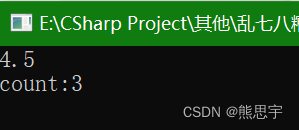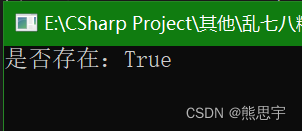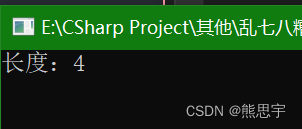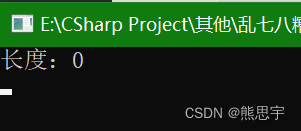Table of contents
3. Determine whether the element exists
4. Get the length of the Stack
I. Overview
A stack represents a simple last-in-first-out (LIFO) non-generic collection of objects.
Stack, like List, is a storage container. It follows the principle of first-in, last-out. It can store any type, but it cannot get to the specified location. It can only be stored and taken out. After taking out the elements, the elements inside the Stack are automatically deleted.
Detailed API reference: Stack class (System.Collections) | Microsoft Learn
2. Basic usage
1. Push into the stack
The push method is used to push into the stack, and any type can be added here
using System;
using System.Collections;
namespace Stack_Test
{
internal class Program
{
static void Main(string[] args)
{
Stack stack = new Stack();
stack.Push("a");
stack.Push("b");
stack.Push(3);
stack.Push(4.5);
Console.ReadKey();
}
}
}2. Pop out
There are two commonly used methods for popping the stack, the first one:
Pop method
using System;
using System.Collections;
namespace Stack_Test
{
internal class Program
{
static void Main(string[] args)
{
Stack stack = new Stack();
stack.Push("a");
stack.Push("b");
stack.Push(3);
stack.Push(4.5);
var value = stack.Pop();
Console.WriteLine(value);
Console.WriteLine("count:" + stack.Count);
Console.ReadKey();
}
}
}run

It can be seen here that the last added 4.5 was taken out first, and it was also deleted from the stack at the same time. At this time, the length is 3. This is the first-in-last-out principle described in the overview, which sounds a bit incomprehensible , In fact, whoever is the last to join will be the first to go out, and the last one in the team will be caught and pulled out.
The second type:
Peek method
using System;
using System.Collections;
namespace Stack_Test
{
internal class Program
{
static void Main(string[] args)
{
Stack stack = new Stack();
stack.Push("a");
stack.Push("b");
stack.Push(3);
stack.Push(4.5);
var value = stack.Peek();
Console.WriteLine(value);
Console.WriteLine("count:" + stack.Count);
Console.ReadKey();
}
}
}run

Peek can take out an element according to the principle of last-in-first-out. It does not delete the element like the Pop method, but it can only take one element. See the code below. Repeated acquisition is useless. If you want to take data one by one When you come out, you still have to use the Pop method honestly.
using System;
using System.Collections;
namespace Stack_Test
{
internal class Program
{
static void Main(string[] args)
{
Stack stack = new Stack();
stack.Push("a");
stack.Push("b");
stack.Push(3);
stack.Push(4.5);
var value1 = stack.Peek();
var value2 = stack.Peek();
var value3 = stack.Peek();
Console.WriteLine(value1);
Console.WriteLine(value2);
Console.WriteLine(value3);
Console.ReadKey();
}
}
}
run

3. Determine whether the element exists
Use the Contains method to determine whether an element exists, as shown in the following code
using System;
using System.Collections;
namespace Stack_Test
{
internal class Program
{
static void Main(string[] args)
{
Stack stack = new Stack();
stack.Push("a");
stack.Push("b");
stack.Push(3);
stack.Push(4.5);
Console.WriteLine("是否存在:" + stack.Contains(4.5));
Console.ReadKey();
}
}
}
run

4. Get the length of the Stack
The acquisition of the length is the same as List, using the Count property
using System;
using System.Collections;
namespace Stack_Test
{
internal class Program
{
static void Main(string[] args)
{
Stack stack = new Stack();
stack.Push("a");
stack.Push("b");
stack.Push(3);
stack.Push(4.5);
Console.WriteLine("长度:" + stack.Count);
Console.ReadKey();
}
}
}
run

5. Traverse the Stack
Stack can be traversed using foreach without removing elements
using System;
using System.Collections;
namespace Stack_Test
{
internal class Program
{
static void Main(string[] args)
{
Stack stack = new Stack();
stack.Push("a");
stack.Push("b");
stack.Push(3);
stack.Push(4.5);
foreach (var item in stack)
{
Console.WriteLine(item);
}
Console.WriteLine("长度:" + stack.Count);
Console.ReadKey();
}
}
}
run

6. Empty the container
Clear the stack using the Clear method
using System;
using System.Collections;
namespace Stack_Test
{
internal class Program
{
static void Main(string[] args)
{
Stack stack = new Stack();
stack.Push("a");
stack.Push("b");
stack.Push(3);
stack.Push(4.5);
stack.Clear();
Console.WriteLine("长度:" + stack.Count);
Console.ReadKey();
}
}
}run

7.Stack generic class
The usage of the Stack generic class and Stack is actually no different. The Stack generic class just has an additional constraint when used. It cannot be the same as the standard form of Stack. You can add any type to the stack, but use a fixed element type
using System;
using System.Collections.Generic;
namespace Stack_Test
{
internal class Program
{
static void Main(string[] args)
{
Stack<string> stack = new Stack<string>();
//将元素入栈
stack.Push("a");
stack.Push("b");
stack.Push("c");
//栈的元素个数
int count = stack.Count;
//是否包含指定的元素
bool b = stack.Contains("a");
//Stack.Peek() 方法返回顶部的对象而不将其从堆栈中移除
string name = stack.Peek();
// Pop 把元素出栈,栈中就没有这个元素了
string s1 = stack.Pop();
Console.WriteLine(s1);
string s2 = stack.Pop();
Console.WriteLine(s2);
string s3 = stack.Pop();
Console.WriteLine(s3);
Console.ReadKey();
}
}
}
3. End
Finally, let's take a look at the features of Stack:
First in, last out, there is boxing and unboxing, and any type is stored. You cannot use the for loop to traverse and view elements, and you cannot obtain the element at the specified position. You can only view and obtain the top element of the stack.
end